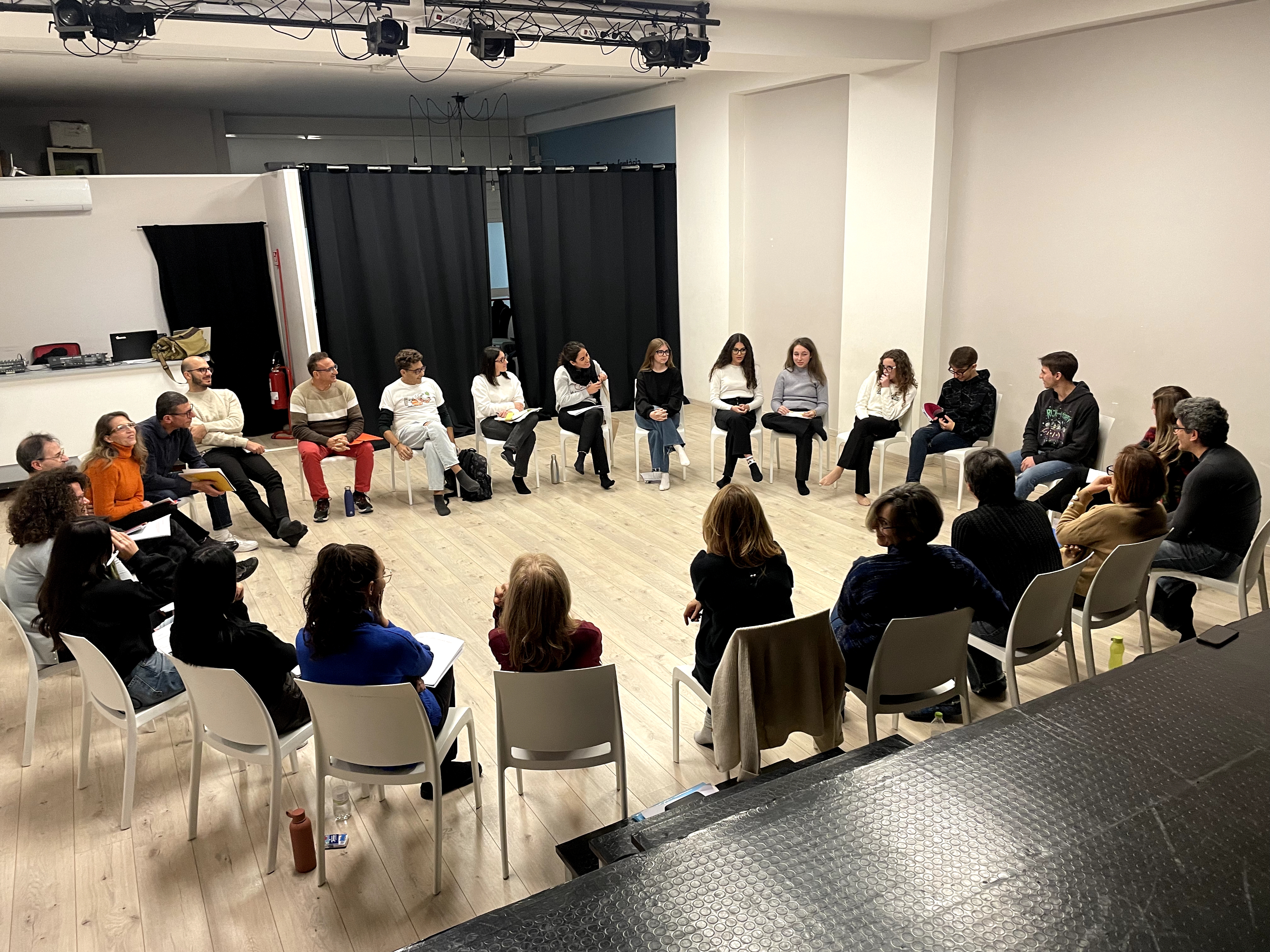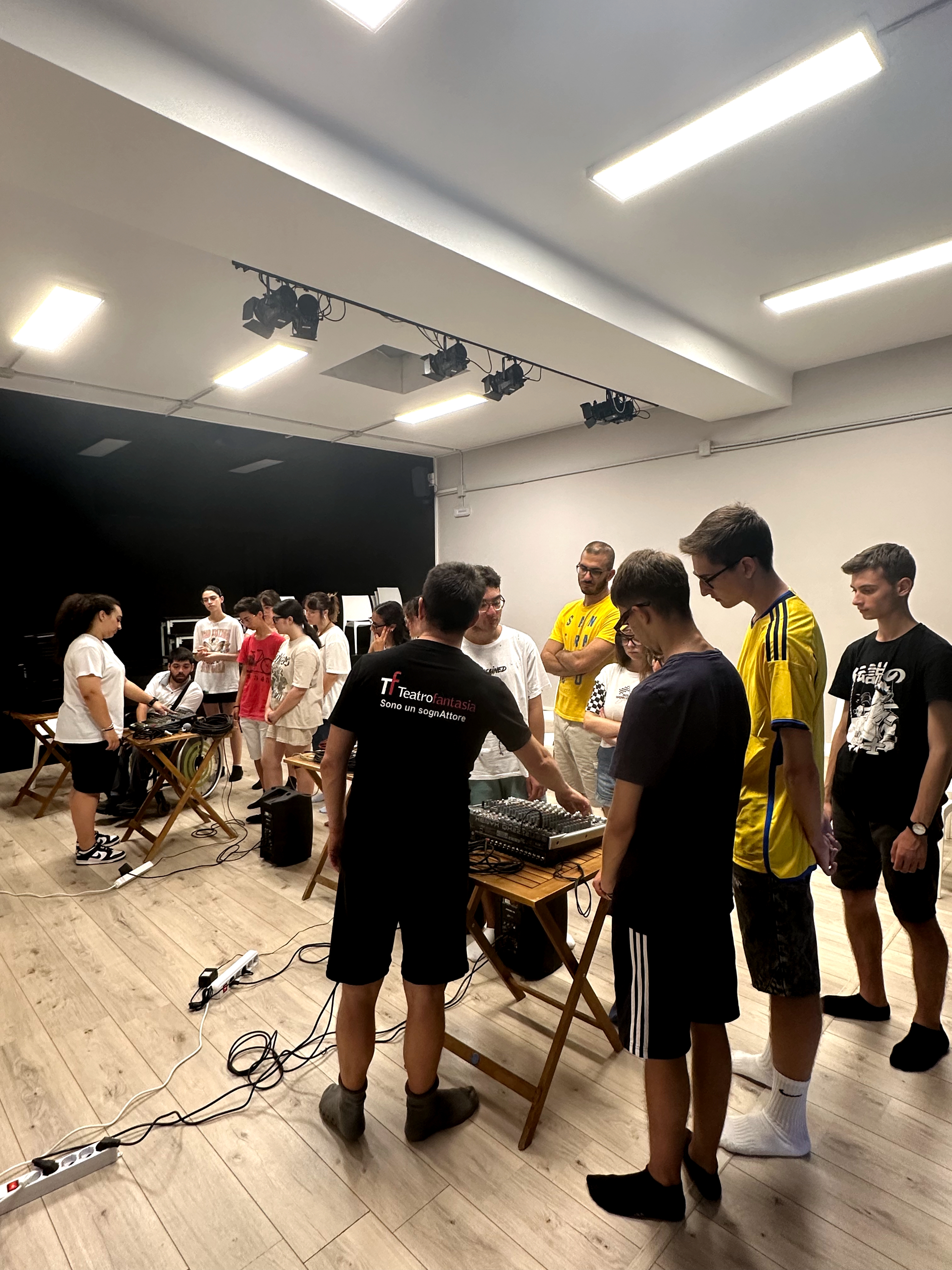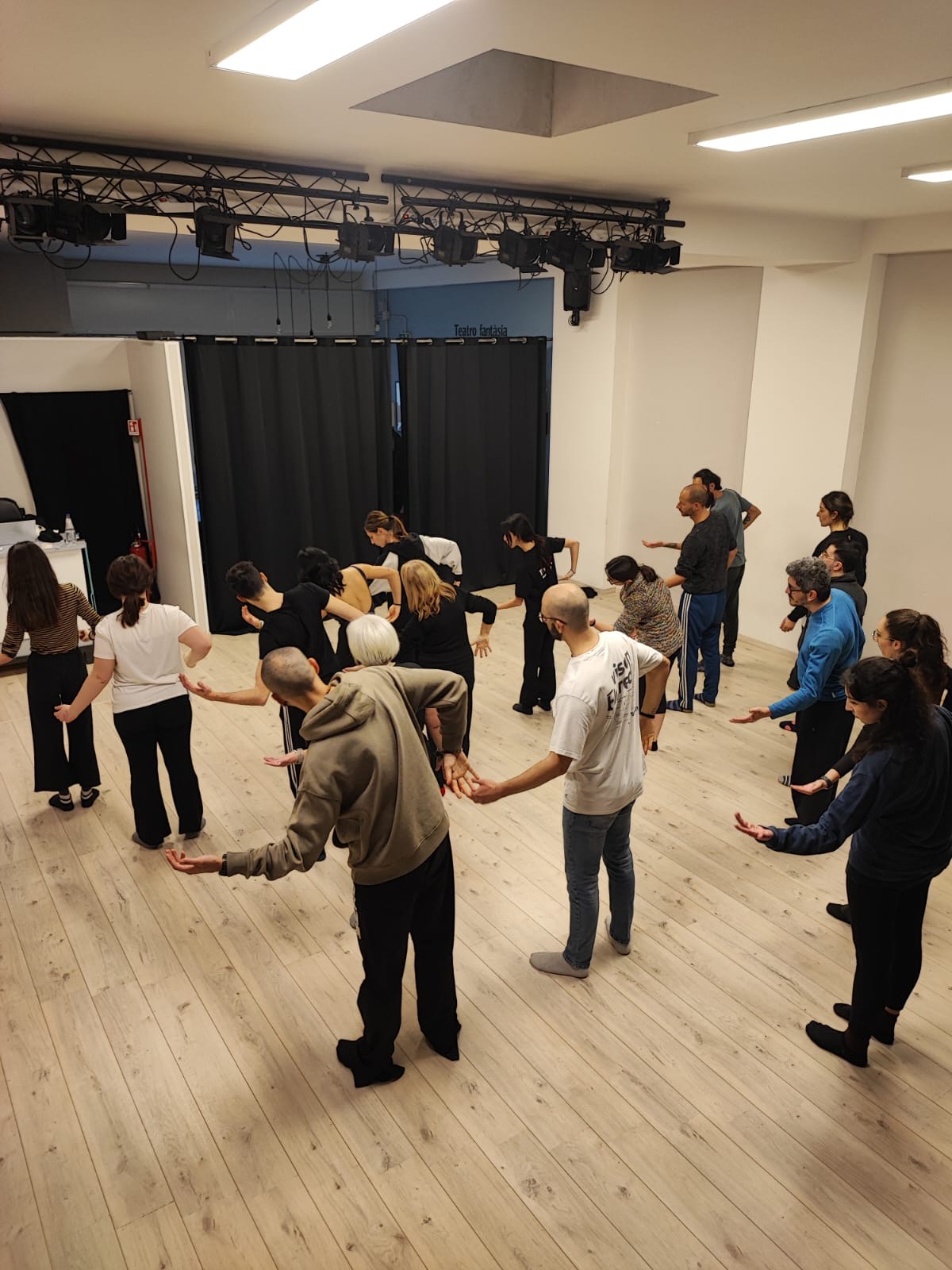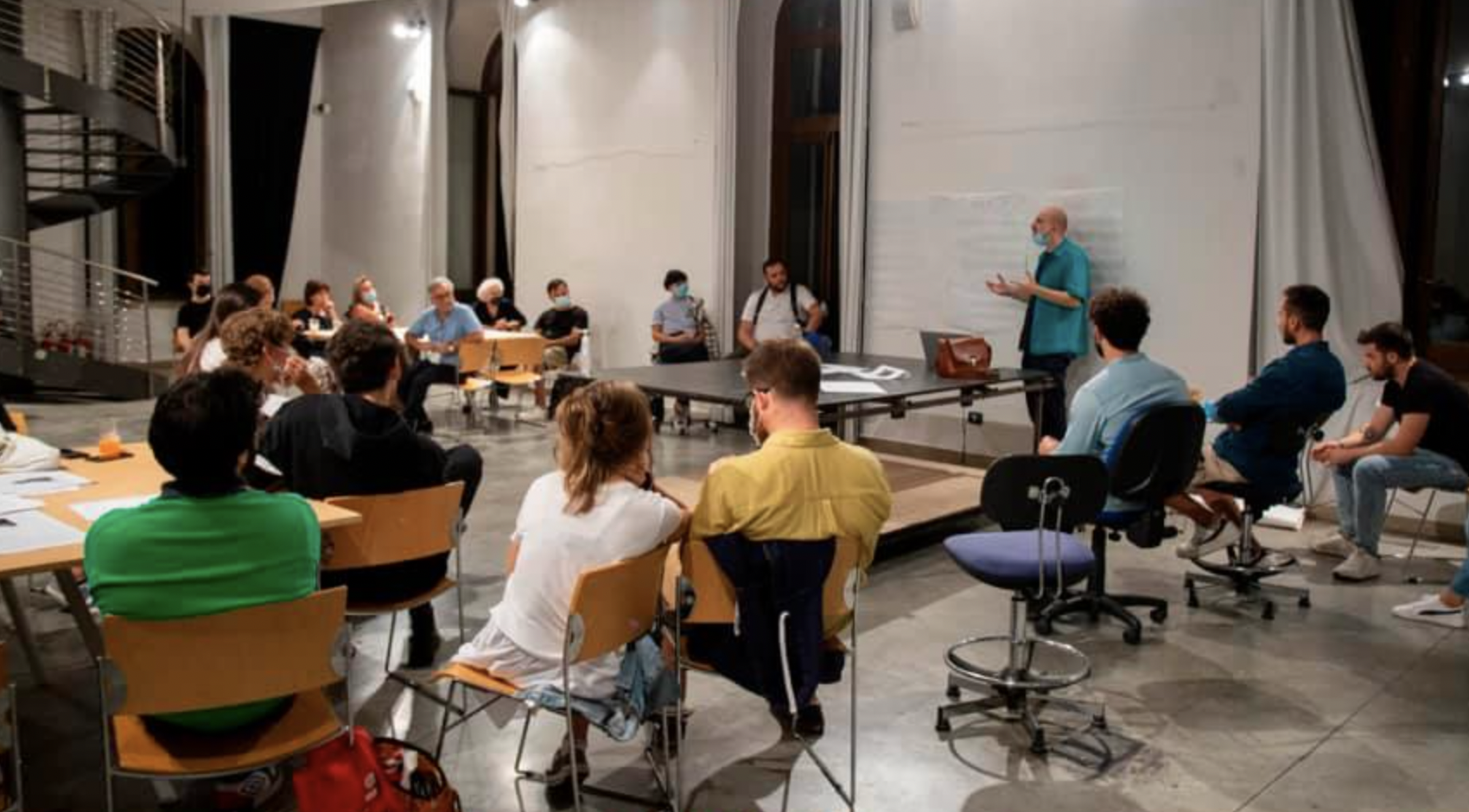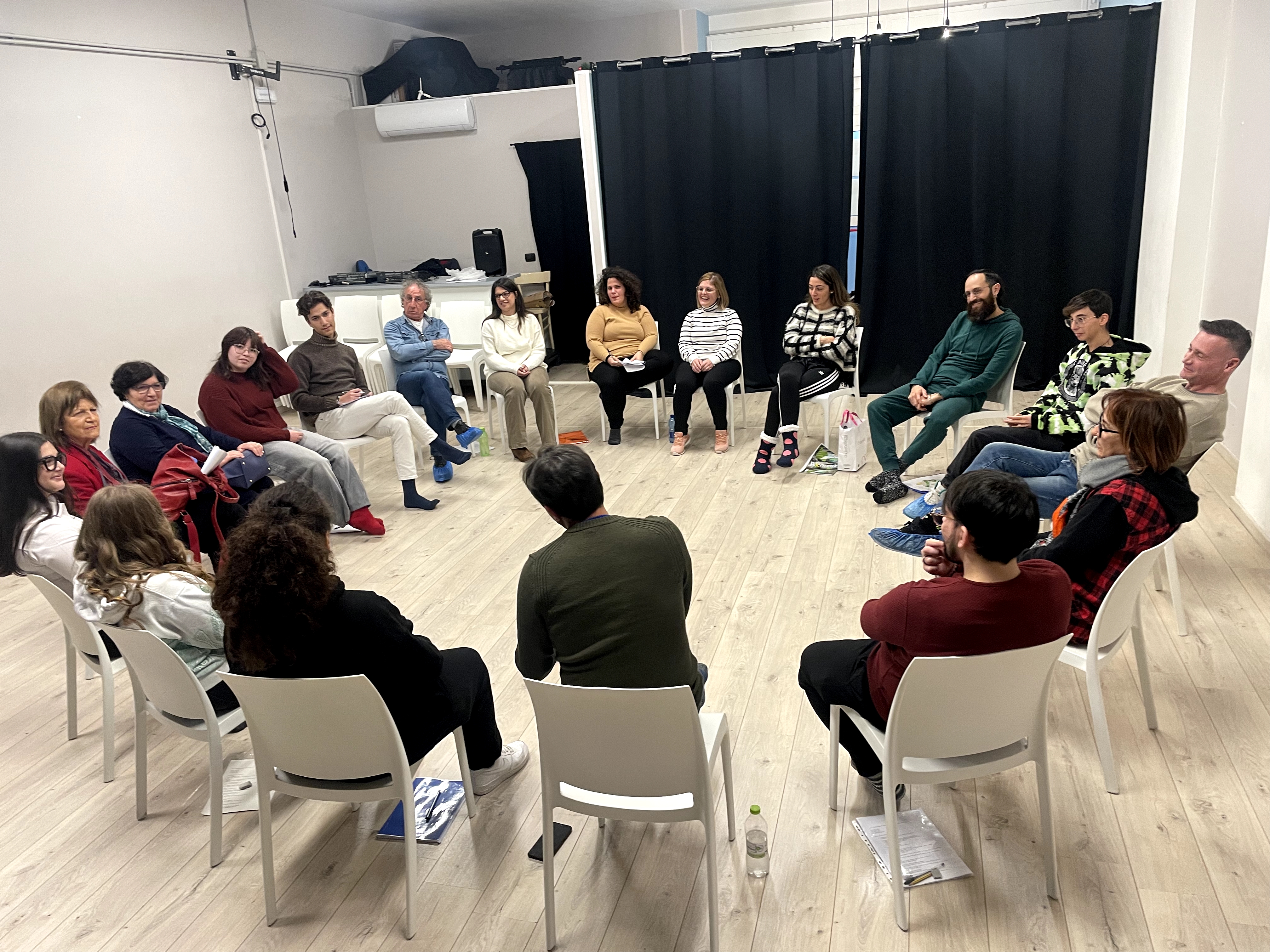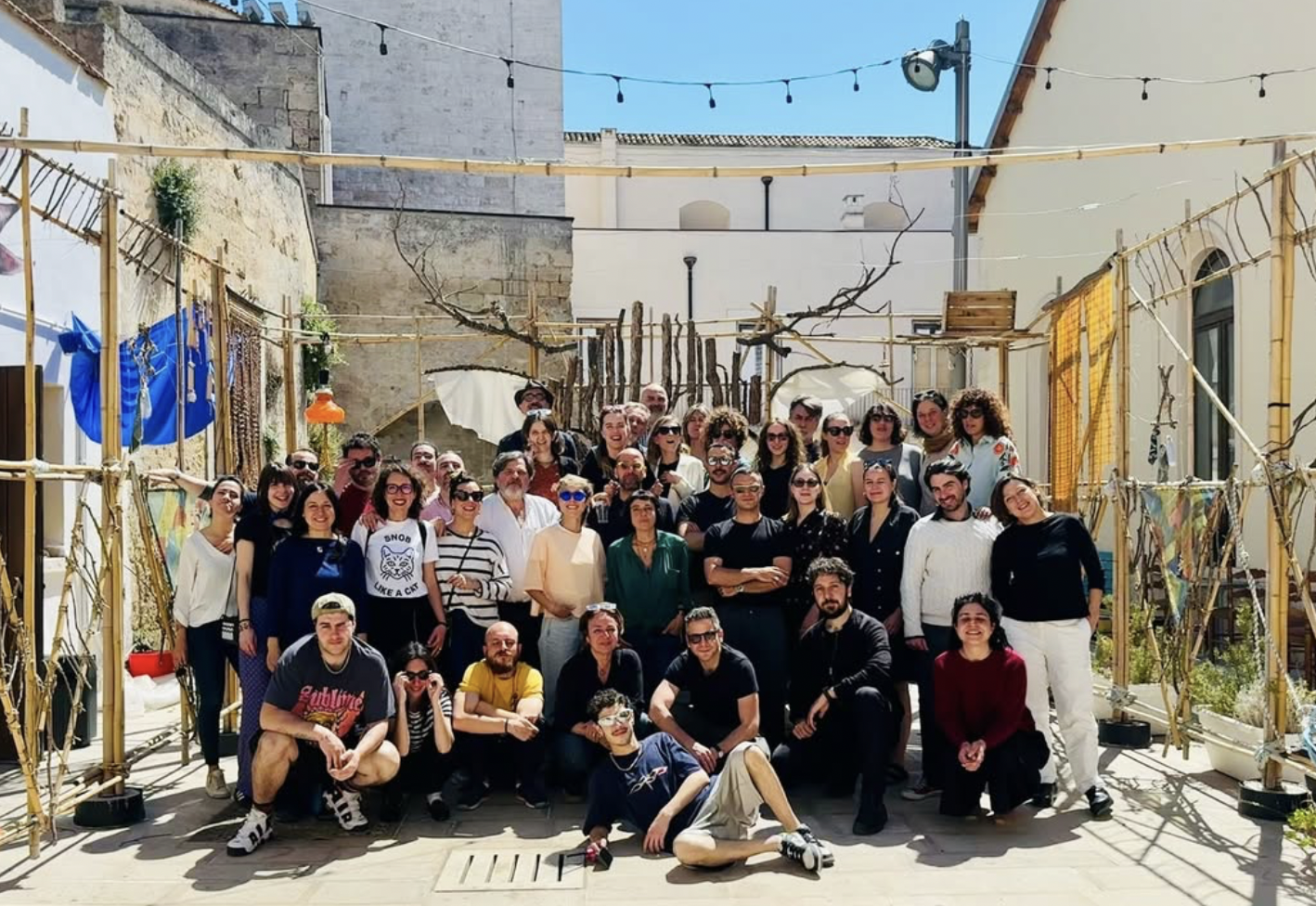Prioritising the places and people that need it the most
Scuola Popolare Delle Arti
Scuola Popolare delle Arti
Scuola Popolare Delle Arti is a cultural regeneration project aimed at bringing horizontal training experiences in the arts that are free and accessible to all. This is a school without walls project that articulates its activity in various cultural centers and organizations operating in the poorest neighborhoods of various cities.
Italy
Regional
Puglia
Mainly urban
It refers to other types of transformations (soft investment)
Yes
2025-02-15
No
No
No
As a representative of an organisation, in partnership with other organisations
“Scuola Popolare Delle Arti” is a project of a widespread school without walls, articulated in cultural centers and organizations located and operating in neighborhoods affected by deep socio-economic distress in 4 cities in Puglia. The project aims to bring high-quality experiences of horizontal and alternative artistic education in the fields of music, theater, and dance, completely free of charge to everyone. Alongside educational activities, the School develops cycles of participatory programming of public performances, exhibitions, lecture series, film forums, etc., carried out with the involvement of the community during the planning and implementation phases, starting from the youth in schools, the residents of the neighborhoods and the visitors of the cultural spaces involved, encouraging experiences of active citizenship in designing the cultural life of the neighborhoods and thus raising awareness of the collective protection of the Common Good, both material and immaterial. Furthermore, through the development of study, research, and production paths that involve both young people from middle and high schools and those already trained at theater academies, dance schools, and music conservatories, “Scuola “Popolare Delle Arti" aims to counteract the phenomenon of school dropout that sees many young people from our provinces, southern peripheries of Europe, leave for central-northern Italy or other European countries in search of exactly this type of experiences that in Southern Italy are generally only available in larger urban centers and are almost absent throughout the rest of the territory.
Accessible educational and cultural experiences for all
Fight against school dropout and the emigration of our local talents
Active cultural citizenship and protection of the Common Good
Participatory programming of cultural life in neighborhoods afflicted by profound socio-economic distress in various Apulian cities
Promote inclusion and integration
"Scuola Popolare delle Arti" embodies and develops various ethical and moral principles. From the need to promote the social and professional inclusion of young people facing socio-economic hardship to ensuring active participation in the shared programming of educational, recreational, and public performance activities in the involved neighborhoods and cities, the project aims to foster active citizenship through collective creative expression.
The sustainability of the project is assessed through various indicators that provide insight into the achievement of its objectives:
* Social: Reducing youth distress in disadvantaged neighborhoods and combating school dropout, promoting transversal inclusion.
* Cultural: Revitalizing community identity and fostering creativity as an act of self-determination.
* Economic: Creating value starting from the most vulnerable segments of the population by ensuring free access to high-quality educational processes for the entire community.
* Environmental: Redeveloping neighborhoods through targeted interventions initiated from cultural centers, promoting a culture of reuse and environmental sustainability.
* Scalability and replicability: The model of a widespread school without walls lends itself to expansion in other urban or rural contexts through the implementation of activities and best practices in cultural centers and organizations that share the project's ethical principles.
* Active participation: Engaging the community across different age groups, social backgrounds, and geographic areas in both the planning and enjoyment of activities.
* Free access: The free nature of all initiatives has eliminated economic barriers, allowing cultural and educational action to serve as a tool for social justice and sustainable development.
The sustainability of the project is assessed through various indicators that provide insight into the achievement of its objectives:
* Social: Reducing youth distress in disadvantaged neighborhoods and combating school dropout, promoting transversal inclusion.
* Cultural: Revitalizing community identity and fostering creativity as an act of self-determination.
* Economic: Creating value starting from the most vulnerable segments of the population by ensuring free access to high-quality educational processes for the entire community.
* Environmental: Redeveloping neighborhoods through targeted interventions initiated from cultural centers, promoting a culture of reuse and environmental sustainability.
* Scalability and replicability: The model of a widespread school without walls lends itself to expansion in other urban or rural contexts through the implementation of activities and best practices in cultural centers and organizations that share the project's ethical principles.
* Active participation: Engaging the community across different age groups, social backgrounds, and geographic areas in both the planning and enjoyment of activities.
* Free access: The free nature of all initiatives has eliminated economic barriers, allowing cultural and educational action to serve as a tool for social justice and sustainable development.
1) Accessibility and Social Inclusion
With the goal of ensuring that all young people, regardless of their socio-economic background, have access to high-quality cultural and artistic experiences, we have successfully eliminated economic barriers to meaningful educational processes. Moreover, we have brought these artistic and cultural experiences directly into disadvantaged neighborhoods, fostering active participation for everyone.
2) Horizontal and Participatory Learning
Aiming to create a non-hierarchical environment and encourage learning systems based on dialogue, collaboration, and collective experimentation, we have promoted an active learning model. This model is rooted in a bottom-up approach, where the subjects of research and study emerge directly from the interests of the participants.
3) Valuing Diversity
Through workshops, performance events, and recreational activities, the project has promoted cultural diversity as a resource, encouraging young people to explore not only different forms of art but also various traditions along with their respective artistic practices, thus broadening their cultural horizons and fostering social integration.
4) Creation of Cultural Communities
The establishment of a partnership among the four cultural centers has fostered the creation of socio-cultural networks between young people and the local community, extending far beyond the neighborhoods and promoting the ethical principles upon which the project is founded across a wider territory. This also facilitates a broader exchange of ideas and the building of meaningful relationships among different communities.
Thanks to the synergy of various local stakeholders and volunteers, the project has offered a high-quality, accessible, and transformative cultural experience, enriching the lives of the participants and the community while demonstrating that art and culture can serve as powerful tools for inclusion, growth, and social change.
With the goal of ensuring that all young people, regardless of their socio-economic background, have access to high-quality cultural and artistic experiences, we have successfully eliminated economic barriers to meaningful educational processes. Moreover, we have brought these artistic and cultural experiences directly into disadvantaged neighborhoods, fostering active participation for everyone.
2) Horizontal and Participatory Learning
Aiming to create a non-hierarchical environment and encourage learning systems based on dialogue, collaboration, and collective experimentation, we have promoted an active learning model. This model is rooted in a bottom-up approach, where the subjects of research and study emerge directly from the interests of the participants.
3) Valuing Diversity
Through workshops, performance events, and recreational activities, the project has promoted cultural diversity as a resource, encouraging young people to explore not only different forms of art but also various traditions along with their respective artistic practices, thus broadening their cultural horizons and fostering social integration.
4) Creation of Cultural Communities
The establishment of a partnership among the four cultural centers has fostered the creation of socio-cultural networks between young people and the local community, extending far beyond the neighborhoods and promoting the ethical principles upon which the project is founded across a wider territory. This also facilitates a broader exchange of ideas and the building of meaningful relationships among different communities.
Thanks to the synergy of various local stakeholders and volunteers, the project has offered a high-quality, accessible, and transformative cultural experience, enriching the lives of the participants and the community while demonstrating that art and culture can serve as powerful tools for inclusion, growth, and social change.
Scuola Popolare delle Arti is an exemplary project in terms of inclusion because it combines accessibility, active participation, and shared planning to create an educational and cultural model that includes everyone. In doing so, it promotes new social models based on collaboration and social justice, recognizing diversity as a source of great enrichment within a community.
The project ensures physical, cultural, social, and economic accessibility, guaranteeing that no one is excluded and actively combating all forms of discrimination. All spaces are fully accessible, and specialized personnel have been employed to provide support tailored to individual needs.
The participatory governance model and bottom-up approach have demonstrated that it is possible to develop inclusive projects even in disadvantaged neighborhoods affected by deep socio-economic hardship, transforming community life and fostering social inclusion, community cohesion and diversity. By fostering innovative social models grounded in exchange, cooperation, and collective advancement, the project has contributed to reducing marginalization and segregation, with the overarching goal of shaping a more equitable and just society, one that acknowledges and enhances diversity as a valuable asset while promoting deeper understanding and stronger social cohesion.
The active involvement of the local community at all levels—from the design and discussion of the project itself to the participation in the planned activities—along with the establishment of an open, assembly-based monitoring and evaluation system, has ensured that the project's core principles were upheld and that its practices were continuously implemented with a virtuous approach. The participation of a large group of volunteers and various local cultural actors ensured that the community played a fundamental role in shaping the project itself.
The project ensures physical, cultural, social, and economic accessibility, guaranteeing that no one is excluded and actively combating all forms of discrimination. All spaces are fully accessible, and specialized personnel have been employed to provide support tailored to individual needs.
The participatory governance model and bottom-up approach have demonstrated that it is possible to develop inclusive projects even in disadvantaged neighborhoods affected by deep socio-economic hardship, transforming community life and fostering social inclusion, community cohesion and diversity. By fostering innovative social models grounded in exchange, cooperation, and collective advancement, the project has contributed to reducing marginalization and segregation, with the overarching goal of shaping a more equitable and just society, one that acknowledges and enhances diversity as a valuable asset while promoting deeper understanding and stronger social cohesion.
The active involvement of the local community at all levels—from the design and discussion of the project itself to the participation in the planned activities—along with the establishment of an open, assembly-based monitoring and evaluation system, has ensured that the project's core principles were upheld and that its practices were continuously implemented with a virtuous approach. The participation of a large group of volunteers and various local cultural actors ensured that the community played a fundamental role in shaping the project itself.
The "Scuola Popolare delle Arti" project actively engaged beneficiaries and civil society through a participatory and inclusive approach. In the cultural centers that embraced this widespread initiative, with the valuable contribution of organizations and volunteers working within them, public meetings, workshops, and focus groups were organized from the early planning stages to gather ideas and understand the needs of the respective communities. This ensured that the activities effectively responded to the real demands of the different territories and neighborhoods. Specific working groups were created for each artistic discipline involved (theater, dance, and music) as well as for public performance activities (festivals and cultural events), bringing together young people, educators, artists, and volunteers from cultural centers and associations. These groups discussed needs and collaboratively defined the structure of both the educational and performance programs. The process was reinforced by periodic assemblies dedicated to monitoring organizational models to ensure they adhered to the project's ethical principles—such as inclusion, sharing, horizontality, and participation. This approach significantly fostered strong community engagement in various activities, nurturing a deep sense of belonging and ownership over the entire project. As a result, the initiative was able to effectively and contextually address the community’s needs.
The organization within the four youth cultural centers and the early involvement of local organizations in the planning stages ensured a collaborative and inclusive approach to the project. Key stakeholders—beyond the hosting organizations and the aforementioned cultural and youth associations—included young people in training, artists, educators, and volunteers.
During the design phase, stakeholders took part in public assemblies to evaluate both the strengths and ongoing programs within the hosting organizations, as well as the additional needs of their communities. These discussions helped shape the planned activities to align with the priorities expressed by the community. As a result, working groups were established for each type of activity and artistic field, actively involving young people in the self-determination of the programs while ensuring transparency, relevance, and inclusivity in the planning process.
During the implementation phase, associations, volunteers, and experts from various disciplines—both local and international guests—provided support and facilitation for the full execution of activities, from educational programs to the realization of the theater series and multidisciplinary festival. The level of engagement was remarkably high: the theater series was practically sold out at every event, and the various workshops consistently had groups of 15–30 participants each. The project generated significant added value: the beneficiaries ensured that the initiative met their needs through active participation from the very beginning; cultural centers, associations, and volunteers strengthened social ties by fostering a network of collaborations; and artists and educators elevated the overall quality of the activities, enhancing their cultural and educational impact.
During the design phase, stakeholders took part in public assemblies to evaluate both the strengths and ongoing programs within the hosting organizations, as well as the additional needs of their communities. These discussions helped shape the planned activities to align with the priorities expressed by the community. As a result, working groups were established for each type of activity and artistic field, actively involving young people in the self-determination of the programs while ensuring transparency, relevance, and inclusivity in the planning process.
During the implementation phase, associations, volunteers, and experts from various disciplines—both local and international guests—provided support and facilitation for the full execution of activities, from educational programs to the realization of the theater series and multidisciplinary festival. The level of engagement was remarkably high: the theater series was practically sold out at every event, and the various workshops consistently had groups of 15–30 participants each. The project generated significant added value: the beneficiaries ensured that the initiative met their needs through active participation from the very beginning; cultural centers, associations, and volunteers strengthened social ties by fostering a network of collaborations; and artists and educators elevated the overall quality of the activities, enhancing their cultural and educational impact.
The project integrated multiple disciplines in its design and implementation, creating a multidisciplinary approach that enriched and amplified its impact. The central focus was on artistic disciplines—specifically theater, dance, and music. Artists, actors, and dancers led horizontal workshops, gathering input from participants to shape educational pathways that aligned with their interests while also inspiring curiosity and encouraging engagement with new artistic expressions. The adoption of horizontal learning systems and the involvement of professional facilitators ensured artistic quality and fostered innovation, transforming participants into active creators and providing an inclusive and stimulating educational experience. Volunteers from various associations, including pedagogues, sociologists, anthropologists, and psychologists, contributed to a deeper understanding of community needs and helped design culturally relevant activities, fostering intercultural dialogue and promoting integration while valuing diversity. Cultural management and project planning experts from the participating associations and cultural centers worked in close coordination, ensuring the project's sustainability and consistency with its objectives. Their efforts also facilitated stakeholder involvement and fostered the creation of collaborative networks across the different cities involved. The multidisciplinary methodology, combined with ongoing dialogue among professionals through coordination and planning assemblies, led to innovative and creative solutions. This holistic approach not only enhanced artistic skills but also promoted individual well-being and strengthened social bonds, proving that cross-sector collaboration can generate a profound and lasting socio-cultural impact.
"Scuola Popolare delle Arti" is a bottom-up iniziative born from strong cultural activism and the collective commitment of a large group of volunteers united by shared ethical principles. The project's goal is to provide free, horizontal, and alternative educational experiences to everyone, without being confined to formal spaces. Instead, it embraces diverse territories and communities through an extensive initiative that brings together civil society organizations (cultural and youth associations, social promotion groups, schools, cultural centers, artistic production entities, neighborhood committees, etc.) and the broader community within this meta-space.
"Scuola Popolare delle Arti" is a school without walls, a widespread educational project that seeks to eliminate both physical and symbolic barriers, bringing education and art directly into neighborhoods and communities with the principle of universal accessibility. The absolute gratuity of all activities—self-determined by the community through assemblies and working groups—along with the active involvement of local organizations and individuals in both the design and implementation of the project, ensures equal opportunities and universal inclusion. It actively fights all forms of discrimination, challenges social inequalities, and guarantees free and open access to culture for all.
But "Scuola Popolare delle Arti" goes beyond simply developing new models of cultural accessibility. It is an urban regeneration project that fosters discussion and experimentation with new social models based on collaboration, solidarity, social justice, and respect for diversity. By promoting dialogue, active citizenship, and social cohesion, it encourages transformative actions that engage the entire community, empowering individuals to become self-determined, active agents of change in a dynamic and multifaceted way.
"Scuola Popolare delle Arti" is a school without walls, a widespread educational project that seeks to eliminate both physical and symbolic barriers, bringing education and art directly into neighborhoods and communities with the principle of universal accessibility. The absolute gratuity of all activities—self-determined by the community through assemblies and working groups—along with the active involvement of local organizations and individuals in both the design and implementation of the project, ensures equal opportunities and universal inclusion. It actively fights all forms of discrimination, challenges social inequalities, and guarantees free and open access to culture for all.
But "Scuola Popolare delle Arti" goes beyond simply developing new models of cultural accessibility. It is an urban regeneration project that fosters discussion and experimentation with new social models based on collaboration, solidarity, social justice, and respect for diversity. By promoting dialogue, active citizenship, and social cohesion, it encourages transformative actions that engage the entire community, empowering individuals to become self-determined, active agents of change in a dynamic and multifaceted way.
"Scuola Popolare delle Arti" was created with the aim of collectively experimenting with active cultural citizenship, working in close collaboration with cultural organizations operating in neighborhoods affected by severe socio-economic hardship in various cities. The project seeks to promote the values of inclusion, social justice, human solidarity, integration, the appreciation of diversity, and freedom of expression.
To develop the project, a dedicated planning committee was established, bringing together cultural centers, artistic production organizations, and youth and cultural associations from the four cities involved. This committee was immediately opened to the entire community to ensure that local needs, interests, and existing initiatives were discussed collectively. As a result, several open working groups were formed to design and implement specific activities, leading to the development of an extensive program of artistic workshops, the creation of open artistic residencies for research and the production of new works, the organization of a theater showcase, and the programming of a multidisciplinary festival.
The active involvement of civil society ensured that the project responded to the real needs of the community rather than an abstract projection of them. The participation of both local and visiting professional artists, along with facilitators and volunteers, gave the project a broad scope, attracting both local and external beneficiaries while ensuring high-quality activities. This, in turn, allowed for a wider dissemination of the project's core values.
To develop the project, a dedicated planning committee was established, bringing together cultural centers, artistic production organizations, and youth and cultural associations from the four cities involved. This committee was immediately opened to the entire community to ensure that local needs, interests, and existing initiatives were discussed collectively. As a result, several open working groups were formed to design and implement specific activities, leading to the development of an extensive program of artistic workshops, the creation of open artistic residencies for research and the production of new works, the organization of a theater showcase, and the programming of a multidisciplinary festival.
The active involvement of civil society ensured that the project responded to the real needs of the community rather than an abstract projection of them. The participation of both local and visiting professional artists, along with facilitators and volunteers, gave the project a broad scope, attracting both local and external beneficiaries while ensuring high-quality activities. This, in turn, allowed for a wider dissemination of the project's core values.
The project was conceived with the ambition of being scaled at both national and international levels, creating a network that brings together a multitude of civil society organizations to revitalize similar contexts in various cities. In fact, we are already working on developing an international network under the name "Invisible Wonders", set to launch in 2026 with an urban regeneration initiative spanning Albania (Tirana), Slovenia (Ljubljana and Nova Gorica), Brazil (Rio de Janeiro), and three Italian cities (Andria, Barletta, and Bitetto).
All the project's features are highly scalable and replicable anywhere in the world. Since the Scuola Popolare delle Arti operates as a school without walls and is structured within independent socio-cultural spaces in collaboration with local organizations, it can be implemented in any part of the world where freedom of thought and speech is upheld. Its governance model, based on participatory and inclusive methodologies for program development and the definition of its multifaceted identity, ensures ongoing adaptability, making it suitable for diverse contexts. This approach fosters transparency, collective responsibility for the Common Good, and active community engagement.
The self-management of different working groups and committees also represents a scalable model, allowing for autonomy and independence in planning activities while safeguarding a plurality of interests. The project's accessible and free nature guarantees its usability beyond geographical and social barriers, ensuring a high-quality artistic and educational process for all. By reducing inequalities and fostering inclusive social models, the project paves the way for transformative and community-driven cultural initiatives worldwide.
All the project's features are highly scalable and replicable anywhere in the world. Since the Scuola Popolare delle Arti operates as a school without walls and is structured within independent socio-cultural spaces in collaboration with local organizations, it can be implemented in any part of the world where freedom of thought and speech is upheld. Its governance model, based on participatory and inclusive methodologies for program development and the definition of its multifaceted identity, ensures ongoing adaptability, making it suitable for diverse contexts. This approach fosters transparency, collective responsibility for the Common Good, and active community engagement.
The self-management of different working groups and committees also represents a scalable model, allowing for autonomy and independence in planning activities while safeguarding a plurality of interests. The project's accessible and free nature guarantees its usability beyond geographical and social barriers, ensuring a high-quality artistic and educational process for all. By reducing inequalities and fostering inclusive social models, the project paves the way for transformative and community-driven cultural initiatives worldwide.
"Scuola Popolare delle Arti" addresses various global challenges by experimenting with new inclusive and participatory social models to promote the values previously described.
- Education: The school offers a non-hierarchical, horizontal educational model through a rich program of permanent workshops, masterclasses, and artistic residencies for research and production in the fields of theater, dance, and music.
- Culture: Through its activities and methodologies, the project fosters the appreciation of diversity, accessibility, equal opportunities, and human and social solidarity.
- Children and Youth: With its entirely free-of-charge approach, the project ensures that everyone can actively participate in the design and implementation of cultural activities (such as festivals, workshops, and artistic showcases) in collaboration with cultural centers, local associations, and both public and private schools, thus strengthening the local associative fabric.
- Inclusion: Scuola Popolare delle Arti operates in neighborhoods facing severe socio-economic difficulties, creating an open and accessible artistic space that fosters inclusion, equal opportunities, social justice, gender freedom, and human rights.
- National and International Cooperation: The project builds a dynamic grassroots network by engaging socio-cultural organizations across various regions, strengthening both local and international social and cultural ties.
- Education: The school offers a non-hierarchical, horizontal educational model through a rich program of permanent workshops, masterclasses, and artistic residencies for research and production in the fields of theater, dance, and music.
- Culture: Through its activities and methodologies, the project fosters the appreciation of diversity, accessibility, equal opportunities, and human and social solidarity.
- Children and Youth: With its entirely free-of-charge approach, the project ensures that everyone can actively participate in the design and implementation of cultural activities (such as festivals, workshops, and artistic showcases) in collaboration with cultural centers, local associations, and both public and private schools, thus strengthening the local associative fabric.
- Inclusion: Scuola Popolare delle Arti operates in neighborhoods facing severe socio-economic difficulties, creating an open and accessible artistic space that fosters inclusion, equal opportunities, social justice, gender freedom, and human rights.
- National and International Cooperation: The project builds a dynamic grassroots network by engaging socio-cultural organizations across various regions, strengthening both local and international social and cultural ties.
The project aligns with the principle of "prioritizing places and people in greatest need." Scuola Popolare delle Arti was implemented in some of the most disadvantaged neighborhoods across four cities in Puglia (Andria, Barletta, Noicattaro, Triggiano), fostering an inclusive and participatory experience of socio-cultural urban regeneration. This was achieved by organizing an educational program in the performing arts, developed with the active involvement of the local community and socio-cultural organizations.
Specifically, the initiative included:
* 10 different theater workshops,
* 3 dance intensive workshops,
* A permanent musical research lab and 3 additional music workshops,
* 3 open artistic residencies, offering young people the opportunity to engage and study with international artists,
* A theater showcase featuring 6 theater companies and 13 sold-out performances,
* A multidisciplinary festival with 11 additional performances.
The use of participatory governance models and the direct involvement of the community in designing both educational and performative activities led to broad engagement in the project, as well as the formation of a cohesive network of civil society organizations and active citizens committed to its continuation. Everyone had the opportunity to take part in the program’s design and coordination, contributing freely through working groups. Participants became agents of change within their communities, helping to build inclusive and solidarity-driven models from the ground up.
The project provided a wide range of beneficiaries with valuable skills in governance models, project development, and self-management—skills that can be applied to the replication and scaling of this initiative, as well as future cultural programs.
Specifically, the initiative included:
* 10 different theater workshops,
* 3 dance intensive workshops,
* A permanent musical research lab and 3 additional music workshops,
* 3 open artistic residencies, offering young people the opportunity to engage and study with international artists,
* A theater showcase featuring 6 theater companies and 13 sold-out performances,
* A multidisciplinary festival with 11 additional performances.
The use of participatory governance models and the direct involvement of the community in designing both educational and performative activities led to broad engagement in the project, as well as the formation of a cohesive network of civil society organizations and active citizens committed to its continuation. Everyone had the opportunity to take part in the program’s design and coordination, contributing freely through working groups. Participants became agents of change within their communities, helping to build inclusive and solidarity-driven models from the ground up.
The project provided a wide range of beneficiaries with valuable skills in governance models, project development, and self-management—skills that can be applied to the replication and scaling of this initiative, as well as future cultural programs.

